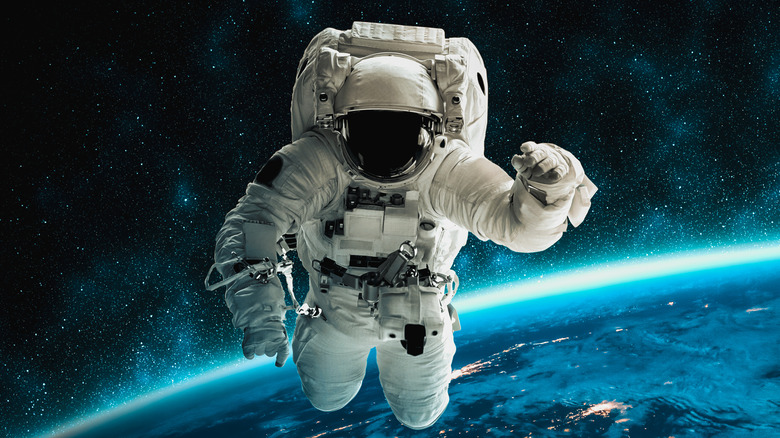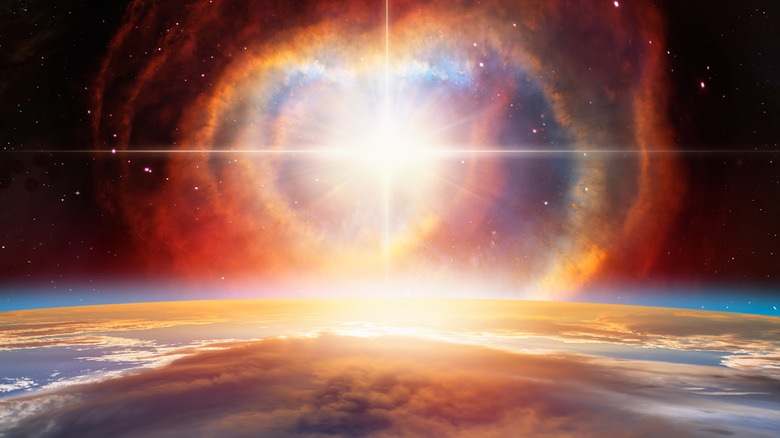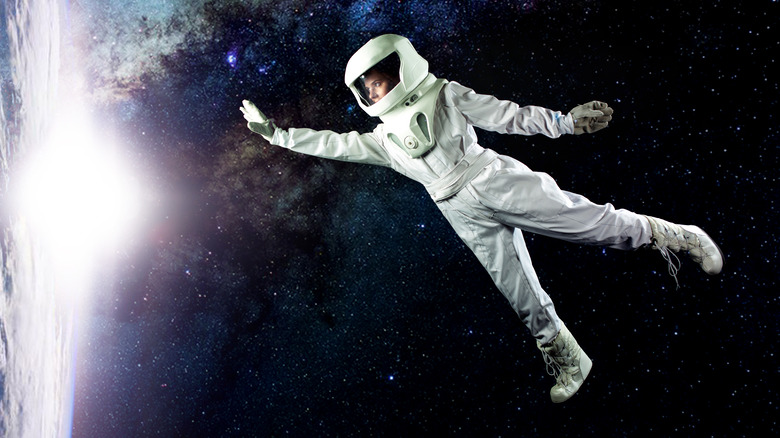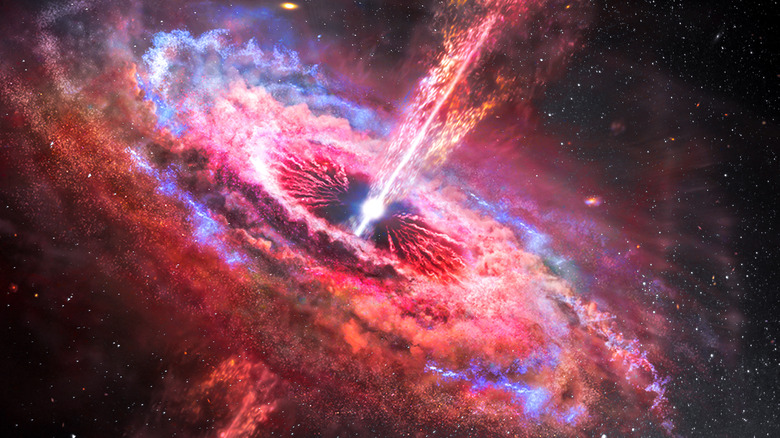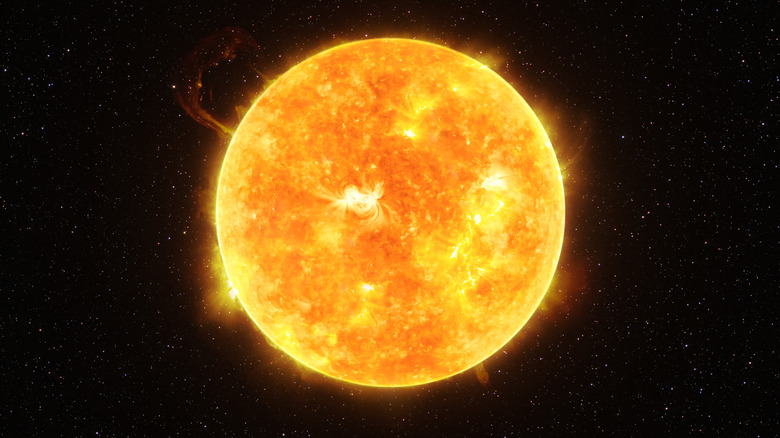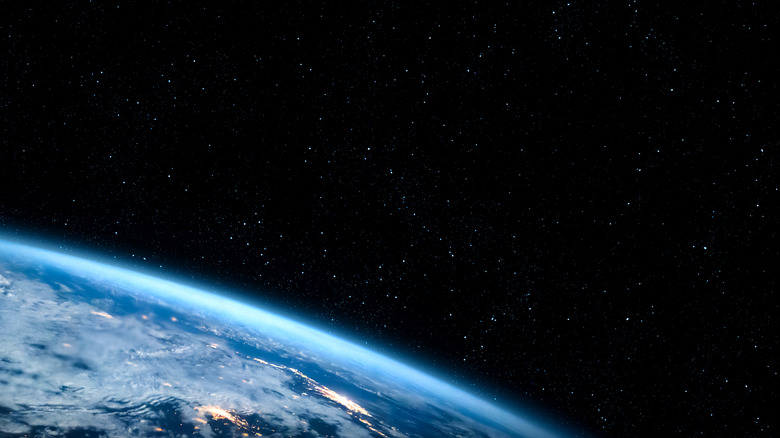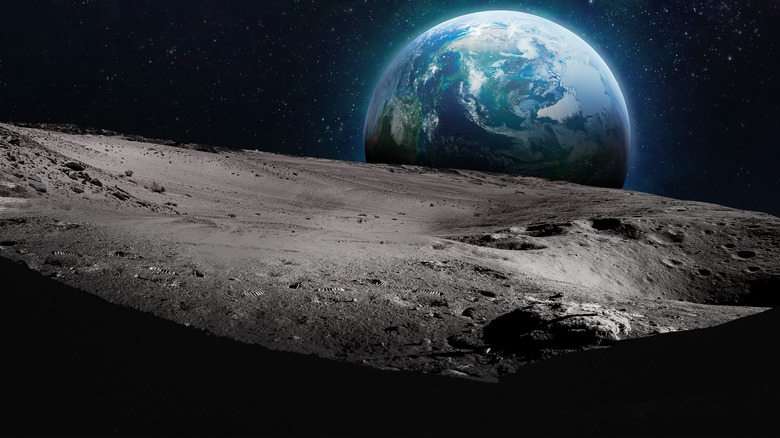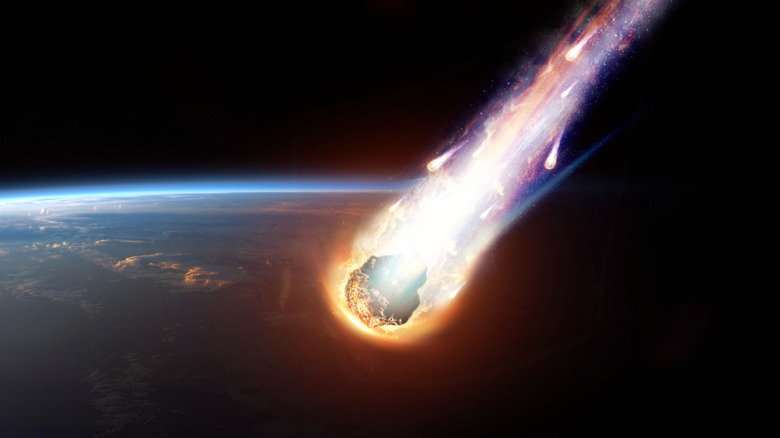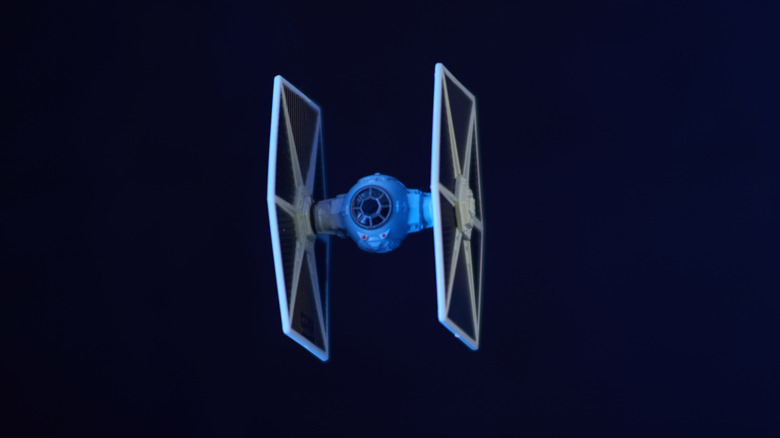Things About Space That Movies Get Wrong
Space has long enthralled and fascinated humanity, quite likely ever since the first human looked up at the night sky and saw bright dots in a vast ocean of darkness. Within the last century, humanity's knowledge and awareness about what lies beyond Earth has greatly increased. Man has managed to travel outside the planet's boundaries and even reach the Moon.
That said, there's still a lot about space that needs to be discovered and understood. In works of fiction and popular culture — especially in movies — the gaps in man's knowledge of space have been filled by creativity and speculation. This has led the general public to assume that the way things play out in outer space on the silver screen accurately reflects how they would turn out in real life.
Of course, no one really goes to the movies to learn about astrophysics or find out if there really is no gravity in space. Still, identifying the things about space that movies get wrong is a fun exercise — one that doesn't necessarily denigrate the films that are guilty of certain interstellar myths and half-truths, but instead paves the way for correcting misconceptions about the cosmos.
Explosions in space are like explosions on Earth
In films like "Star Wars" and "Star Trek," it's not uncommon to see spaceships blowing up space debris or even other spacecraft. These sequences typically end in bright, fiery spectacles, which really helps sell the idea to audiences that something just exploded. There's just one small problem: Objects that get blown up in space wouldn't really look or sound like Earth-bound explosions.
As Science Focus explains, when stars, planets, and other celestial bodies "explode," the process involves a powerful release of energy and matter. This can happen either from within them or due to external forces. Either way, they undergo fundamental changes. What they don't do, though, is turn into gigantic fireballs like, say, an exploding car would. In the vacuum of space, such a flaming spectacle — which requires either oxygen or an additional oxidizing substance — wouldn't happen.
Additionally, whatever explosion comes out of this situation wouldn't be as loud as the space explosions we see in many science fiction movies. Due to space being a vacuum, the released gases would rapidly expand as the density decreases. In other words, any sounds that accompany the gas would become less audible over longer distances, and this would all happen very fast. Cornell Astronomy presents an interesting scenario that illustrates this: Even if you were aboard a spacecraft and an adjacent ship exploded, you'd be more likely to hear the pieces of the ship hitting your craft than any sounds from the actual explosion.
There is no gravity in space
One of the most common misconceptions about space is that it has no gravity. Countless films show characters floating around (either in the vastness of space or within their own spaceships), which serves to reinforce this belief. It also doesn't help that when talking about space-related topics, the term "zero gravity" tends to be taken literally. The truth, however, is that there is gravity in space — just a lot, lot less than the gravity here on Earth.
As NASA explains, an infinitesimal amount of gravity can be found everywhere in space. That's why it's called "microgravity": There's so little of it that when things or people make it to space, they seem to float as if they're lighter than feathers. If one were to remove gravity from space, the results would be catastrophic: For example, without gravity, planets and their moons wouldn't be able to maintain their orbits.
According to Dr. Christopher S. Baird, Assistant Professor of Physics at West Texas A&M University, the microgravity in space causes things to constantly fall towards celestial bodies. He also provides two reasons why things in space seem to be simply floating instead of falling: "First, space is very large and relatively empty by earth standards ... The second reason that gravity is not so obvious in space is because objects tend to orbit planets instead of hitting them. Orbiting just means that an object falls towards a planet due to gravity and continually misses it."
Black holes suck everything in
The idea that black holes suck everything in has become so prevalent in popular culture that people even use it as a metaphor. This has reinforced the notion that black holes are "giant space potholes" that rapidly pull everything in. One of the most recent examples of this was how the Narada got destroyed in the "Star Trek" reboot — audiences witnessed its speedy end in spectacularly destructive fashion. However, such a scenario wouldn't play out like that in real life. In other words, black holes don't exactly work like cosmic vacuum cleaners.
Space.com puts it quite plainly: "Black holes don't suck." They don't have infinite suction power to draw everything within their vicinity into them. Instead, objects that end up very close to black holes fall into them and are unable to escape their gravitational pull. "At a distance, black holes really don't have more gravity than normal objects, so at a distance they really won't suck things in any more than a normal object of the same mass," explained Jerry Fishman, a scientist from NASA's Marshall Space Flight Center, in an edition of the agency's Ask an Expert chat.
That said, this doesn't mean that falling into a black hole won't be an absolutely awful experience. A 2012 study published in Nature theorized that due to quantum effects, you would likely be burnt to a crisp as you pass through the event horizon (the black hole's "point of no return").
It would be hard to fly through the asteroid belt
People who grew up idolizing the likes of Han Solo likely believe that piloting a spacecraft requires unbelievable dexterity and driving skills. And while operating any vehicle does require a decent level of technical expertise, the idea that a space driver would have to pull off a Hail Mary every time they cross a formation like the asteroid belt between Mars' and Jupiter's orbits is a bit misleading.
According to Cornell Astronomy, asteroids and other rock formations in space are spread out widely enough that the possibility of a spacecraft colliding with them is extremely small. For starters, Earth's systems are capable of detecting asteroids that are up to 50 km (about 31 miles) in size. Plus, as far as space missions are concerned, their routes are mapped out years before takeoff, which essentially means that driving a spacecraft is more about following a plan and accounting for minor inconsistencies in the trajectory, and less about driving like a space cowboy. As David Morrison of the NASA Ames Research Center explained to Scientific American: "Collisions are thus extremely rare; an average 1-kilometer asteroid suffers one collision every few billion years, or maybe one or two collisions over the lifetime of the solar system."
That said, space collisions do happen, and can still cause some problems. Per Cornell Astronomy, sand-sized micrometeorites and cosmic radiation often hit spacecraft hulls, which can result in anything from minor damage to technical glitches.
The Sun is yellow (and on fire)
Ask an average person on the street — or perhaps even better, ask the people behind the films "Sunshine" and "Green Lantern" — to draw and color a picture of the Sun. They'd probably ask you for a piece of paper, a pencil, and a yellow crayon, and give you a sketch of a giant yellow fireball minutes later. (Or they'd just walk away from you, because who randomly asks strangers on the street to draw the sun, right?)
In reality, though, the Sun is neither yellow nor on fire, at least not in the traditional sense. According to NASA StarChild, the Sun's impressive cosmic glow is the result of protons smashing into each other within its gaseous body. This process is called nuclear fusion, and when the particles collide, they release energy. Per estimates from Space.com, the sun turns 700,000,000 tons of hydrogen into 695,000,000 tons of helium every second, and the resulting energy released is gamma radiation. Unlike a fire, oxygen doesn't need to be present for this to happen (although high pressure and temperatures are definitely a must).
While the Sun is classified as a yellow dwarf star and certainly does look yellow to human eyes, its true color is actually white (via Science Focus). It only appears to be yellow because when the light reaches Earth's atmosphere, blue light gets scattered — and the remaining wavelengths that reach the planet make the star look yellow.
You can hear sounds in space
When it comes to movies set in outer space, sound tends to be a peculiar aspect. On one hand, anyone who was raised on a diet of "Star Trek" or "Star Wars" likely hears the "Pchew! Pchew!" of lasers fired from spaceships in their heads. On the other hand, there's that ominous-sounding (pun intended) tagline of 1979's "Alien": "In space no one can hear you scream." The reality is a bit less simple than either scenario (but is a lot closer to the latter).
Per Cornell Astronomy, air is absent in the vacuum of space. Which is a problem if you want to hear things, because hearing sound is only possible when there's a proper medium for molecules to vibrate through. That's why light can travel through space with no problem — it doesn't need air — but isn't accompanied by sound. That said, because there are gas clouds in space, sound can travel through them. However, because they're not as dense as the gases in Earth's atmosphere, human ears aren't designed to hear the sounds that travel through them. A powerful microphone designed for such a purpose could possibly pick them up, though.
As for sound traveling unassisted between planets, because there isn't really any matter (solid, liquid, or gas) between, say, Earth and Venus through which sound waves could travel, it just wouldn't work. Long story short, "Alien" got it right — if by "no one," it meant "no human without the proper technology."
Nothing is faster than light
When people hear the words "speed of light," they usually think of it as an impossible-to-surpass speed limit. After all, 670,616,629 mph is certainly nothing to scoff at, right? And while it's true that the laws of physics prevent anything with mass to travel faster than light — meaning you won't be able to physically take a spaceship beyond the limits of the speed of light — to say that nothing can travel faster than light isn't 100% accurate.
As Business Insider explains, a sort of "luminal boom" takes place when electrons travel faster than light in water. The formal term for this is Cherenkov radiation (named after the physicist who first measured it), and it manifests as a blue glow, typically in nuclear reactors. Britannica defines it as "light produced by charged particles when they pass through an optically transparent medium at speeds greater than the speed of light in that medium." So technically, because of the medium in which the particles are traveling, they outpace the light that's also moving through it; however, they're not moving faster than the actual speed of light.
But if that's the case, then how can humanity ever unlock the secret of instant teleportation? Scientists will need to get a bit more creative. Space.com suggests focusing not on the object that will be transported, but on the space around it (e.g. "a spaceship that could fold a space-time bubble around itself").
A person without a spacesuit would instantly explode in space
When "Total Recall" showed audiences the consequences of an astronaut's helmet cracking while on a mission, the results were disturbing, to say the least. However, while an unprotected human would certainly have an unpleasant experience in space, it probably wouldn't unfold that way. For starters, astronauts' suits are designed to hold up against space wear and tear, as NASA astronaut Nicole Stott explained in a video for Wired.
More importantly, a naked human body wouldn't instantly blow up or freeze to death in outer space — but what would happen inside that body would be far more horrific. As Dr. Christopher S. Baird of West Texas A&M University put it: "Even though outer space represents a lack of air pressure, which usually counters the internal pressure in our bodies, our tissue is strong enough to handle the imbalance." It's actually the lack of oxygen that would kill an unprotected person in outer space. That, and sudden decompression, which is one of the worst ways to die for a human being. According to Harvard University, the air in a person's lungs would expand rapidly in the vacuum of space, which could result in lung rupture, ebullism (which could turn one's tissues into vapor), blood vessel blockage, and death. Experiments have revealed that in such a vacuum, a person can survive for about a minute, tops.
The dark side of the moon
The dark side of the Moon has become such a fixture in popular culture that filmmakers even named a "Transformers" movie after it.
The Moon's so-called "dark side" is based solely on the point of reference of people on Earth, as it's the side of the satellite that never faces the planet due to a phenomenon called "tidal locking" (per the National Space Centre). In a nutshell, because the Moon has been traveling around the planet for such a long time, the smaller celestial body's rotation has slowed down to the point where the amount of time it takes for the Moon to rotate around its axis matches how long it takes to complete one around-the-world trip.
However, this doesn't mean that the side of the Moon Earth never sees is a perpetually dark and cold place. Evidence exists to disprove this notion, in the form of photographs taken of the Moon's perpetually "hidden" side, showing that it receives just about the same amount of sunlight as its visible half (per Yale Scientific). Simply put: "[T]he far side of the moon is no more and no less dark than the hemisphere we do see."
The meteorites that crash into Earth are hot
If you've ever seen disaster movies like "Deep Impact," you probably have the notion that when a meteorite crashes through Earth's atmosphere and lands on the ground, it's a bright fireball that creates a massive, intensely hot crater upon impact. Curiously enough, this couldn't be further from the truth.
As Donald Yeomans, manager of the Near Earth Object program at NASA's Jet Propulsion Laboratory, explains: "The outer layers [of objects from space] are warmed by atmospheric friction, and little bits flake away as they descend." According to Yeomans, since space rocks are generally ineffective heat conductors, their rocky centers maintain the cold temperatures (which match the temperatures of deep space) even as their outer layers are vaporized by the heat that Earth's atmosphere subjects them to. This process is called ablation, and it's the same principle that allows certain types of commercial heat shields to protect the astronauts inside spaceships that are re-entering Earth.
In his online Q&A, physics educator Dr. Christopher S. Baird cites meteoritics expert Harry Y. McSween: "Meteorites have been stored in the deep freeze of space for eons, an atmospheric heating does not significantly affect their interiors because heat conduction in stones or even iron takes much longer than the minute or so required for atmospheric transit."
Instant communication in space
It's a familiar scenario to anyone who has ever seen a sci-fi film: the pilot of one spaceship light-years away (which, despite the implications of its name, is a measure of distance, not time) instantly communicating with home base or another spaceship through the power of movie space science. Sometimes, they're even shown doing this while pulling off a daring escape in a high-speed space chase. Unfortunately, due to the limitations of pesky physics, such a scenario wouldn't pan out like that in real life.
According to NASA, there's a "universal speed limit" to communications: the speed of light. And while that distance doesn't significantly affect transmissions between Earth and nearby spacecraft, it becomes a problem as the distance between two communicating bodies increases. Per the BBC, a conversation between a person on Earth and a person on Mars would be "very stilted" due to the sheer distance between them. (NASA provides a more specific range — from four to 24 minutes, depending on how close or how far the planets are at a given point in time — in a possible Earthling-Martian conversation).
The BBC also mentions the Voyager spacecraft which, as of 2015, were approximately 19.5 billion km (about 12.1 billion miles) away from Earth; messages from the spacecraft actually took 18 hours to reach the planet. A quick "hello" to the nearest star system to Earth, Alpha Centauri? You'll have to wait about half a decade for the message to reach them.
Spaceships would fight and move like fighter planes
Admittedly, part of the reason why people pay to see space epics in cinemas is to witness those super-cool cosmic dogfights. It's hard to find a "Star Wars" fan who wouldn't be up for a no-holds-barred battle between a fleet of X-wings and a batch of Imperial TIE fighters, playing out exactly like World War II aerial combat. In real life, though, space skirmishes would be far less exciting, and would be more about careful, precise strikes than typical warplane tactics.
A 2020 paper described space warfare as being deliberate and slow. For starters, because of physics, the vastness of space, and the fact that spacecraft have to follow specific paths for travel, attacks would be generally predictable, and shooting opponents would require "complex calculations ... in a highly engineered domain."
The Conversation speculates about what a space war would look like to people who are watching from Earth: There wouldn't be much to see, basically. "Any observers on the surface would be unlikely to directly see any effects from space warfare, unless a kinetic kill actually breaks a spacecraft up — with debris lighting up as it re-enters the atmosphere."
